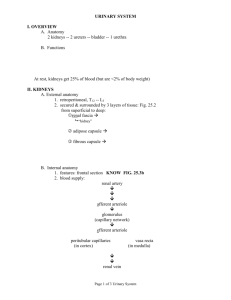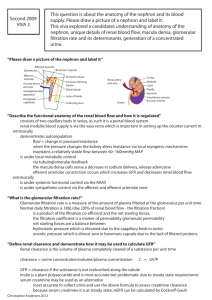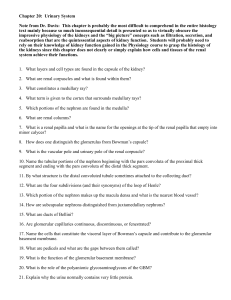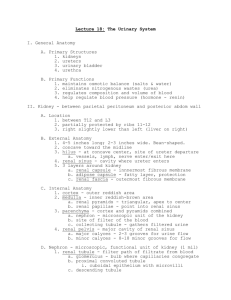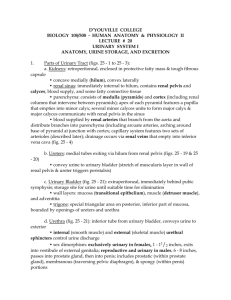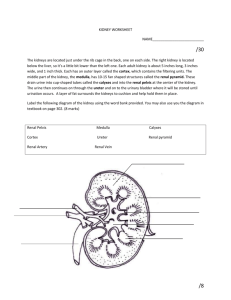Basic renal physiology - Ohio State University
advertisement
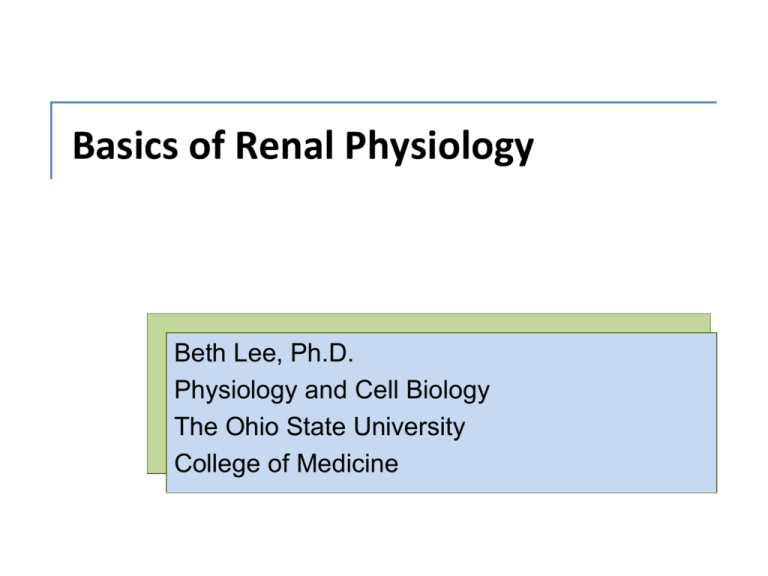
Basics of Renal Physiology Beth Lee, Ph.D. Physiology and Cell Biology The Ohio State University College of Medicine Objectives Define Describe At the end of this module, you will learn to: the major functions of the renal system. the 2 types of nephrons and their anatomical differences Define the segments of nephrons in the order in which filtrate passes through. Describe the components of the renal corpuscle and the filtration barrier. Describe the components of the juxtaglomerular apparatus. Define the three basic renal processes. Renal Physiology Text DC Eaton and JP Pooler, Vander’s Renal Physiology, 6th or 7th edition McGraw-Hill Inc.. This is a concise, well-written book (in paperback, and therefore inexpensive!) that was put together with the needs of medical students in mind. It lists learning objectives and gives sample questions. I use this as the basis for my lectures. For this lecture, please read Chapter 1. Today’s Topic Outline Overall renal function Anatomy of nephrons Anatomy of the renal corpuscle and filtration barrier Juxtaglomerular apparatus Basic renal processes Overall Renal Function The kidneys process the plasma portion of the blood so that whatever is not needed to maintain homeostasis is excreted in the urine. This is done by a combination of plasma filtration and subsequent alteration of the content of this filtrate. Renal Function Regulation of total body water and osmolality Regulation of electrolyte balance Sodium, the major extracellular cation Potassium, the major intracellular cation Chloride, the major extracellular anion Regulation of acid-base balance Regulation of mineral balance Calcium Phosphorus Renal Function (cont.) Excretion of metabolic products Urea, the major end product of protein catabolism Uric acid, a product of nucleic acid catabolism Creatinine, produced by skeletal muscle End products of hemoglobin breakdown (responsible for the color of urine) Excretion of foreign substances Drugs Food additives Renal Function (cont.) Production and secretion of hormones Erythropoietin (Epo), regulator of red blood cell production Renin, regulates sodium balance and blood pressure 1,25-Dihydroxyvitamin D3, the active form of vitamin D Gluconeogenesis during fasting: the kidney, along with the liver, contributes to generation of glucose from amino acids and triglycerols Relationship of Nephron to Kidney Nephrons: the Functional Units of the Kidney Flow of Filtrate through the Nephron The Renal Corpuscle Bowman’s capsule Afferent arteriole Bowman’s space Efferent arteriole To nephron tubules Glomerular capillaries Podocytes Filtration Barrier of the Glomerulus Podocytes Scanning electron micrograph of rat podocytes Podocytes Podocyte cell body Podocyte foot processes Basement membrane Fenestrated endothelial layer The Nephron Tubule Proximal convoluted tubule Distal convoluted tubule Collecting duct Descending thin limb of loop of Henlé Ascending thick limb of loop of Henlé Juxtaglomerular Apparatus (JGA) Quiz #1 Place these nephron segments in the same order as the direction of blood flow: A. Loop of Henle B. Collecting Duct C. Glomerulus D. Proximal Convoluted Tubule E. Proximal Straight Tubule F. Distal Convoluted Tubule Give feedback for this answer (The correct answer is C, D, E, A, F, B). Quiz #2 Which of these cell types are not part of the juxtaglomerular apparatus? A. Podocytes B. Extraglomerular mesangial cells C. Juxtaglomerular cells D. Granular cells E. Macula densa cells (The correct answer is A.) Give feedback for each answer: why correct and incorrect. Basic Renal Processes Glomerular filtration Reabsorption of filtered solutes from the tubule to the blood stream Secretion of solutes from the blood stream to the tubule Glomerular Filtration Blood flow (RBF) = 1.1 L/min Plasma flow (RPF) = 605 ml/min Bowman’s capsule Afferent arteriole Bowman’s space GFR = 125 ml/min To nephron tubules Glomerular capillaries Podocytes Efferent arteriole Renal Blood Flow v. Renal Plasma Flow (RBF v. RPF) Blood volume = 45% cells and 55% plasma (average values) The RPF can be calculated as 55% of the RBF: 1.1 L/min X 0.55 = 0.605 L/min = 605 ml/min Reabsorption and Secretion Blood Tubule lumen Cell R S Apical Basolateral Reabsorption is the net movement of solutes from the tubule lumen to the blood (the peritubular capillaries and vasa recta). Secretion is the net movement of solutes from the blood to the tubule lumen. The Nephron, Simplified Renal Handling of Hypothetical Solutes Renal Handling of Common Solutes Metabolism by Tubule Cells Metabolism by tubular epithelia has not traditionally been considered a basic renal function, but it does certainly alter the composition of plasma and urine. Some metabolism occurs simply for the cells’ own nutritional needs. Other occurs in a specific attempt to change plasma and urine composition (e.g. formation of H+ and HCO3- in regulating blood acid-base balance). Functions of Different Segments of the Nephron Glomerulus: filters blood volume 60 times per day Proximal tubule: Reabsorbs most of filtered salt (NaCl) and water Reabsorbs a fraction of other important ions (phosphate, calcium, bicarbonate, potassium) Reabsorbs useful organic substances (e.g. amino acids and glucose) Secretes metabolic waste products and drugs Functions of Different Segments of the Nephron (cont.) Loop of Henle: determines osmolarity of the urine by reabsorbing varying levels of salt and water Distal tubule (and connecting tubule): reabsorbs a small percentage of salt and water Cortical collecting duct: responsive to aldosterone and ADH to regulate salt and potassium balance Medullary collecting duct: also regulates salt and water balance; regulates urea reabsorption and acid-base balance Summary References Thank you Thank you for completing this module. If you have any questions, please contact me. Beth.Lee@osumc.edu Survey We would appreciate your feedback on this module. Click on the button below to complete a brief survey. Your responses and comments will be shared with the module’s author, the LSI EdTech team, and LSI curriculum leaders. We will use your feedback to improve future versions of the module. The survey is both optional and anonymous and should take less than 5 minutes to complete. Survey
